Salyut programme
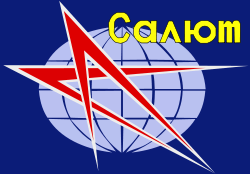
The Salyut programme (Russian: Салю́т, IPA: [sɐˈlʲut], meaning "salute" or "fireworks") was the first space station programme, undertaken by the Soviet Union. It involved a series of four crewed scientific research space stations and two crewed military reconnaissance space stations over a period of 15 years, from 1971 to 1986. Two other Salyut launches failed. In one respect, Salyut had the task of carrying out long-term research into the problems of living in space and a variety of astronomical, biological and Earth-resources experiments, and on the other hand the USSR used this civilian program as a cover for the highly secretive military Almaz stations, which flew under the Salyut designation. Salyut 1, the first station in the program, became the world's first crewed space station.
Salyut flights broke several spaceflight records, including several mission-duration records, and achieved the first ever orbital handover of a space station from one crew to another, and various spacewalk records. The ensuing Soyuz program was vital for evolving space station technology from a basic, engineering development stage, from single docking port stations to complex, multi-ported, long-term orbital outposts with impressive scientific capabilities, whose technological legacy continues to the present day. Experience gained from the Salyut stations paved the way for multimodular space stations such as Mir and the International Space Station (ISS), with each of those stations possessing a Salyut-derived core module at its heart.
Mir-2 (DOS-8), the final spacecraft from the Salyut series, became one of the first modules of the ISS. The first module of the ISS, the Russian-made Zarya, relied heavily on technologies developed in the Salyut programme.
History of Salyut space stations
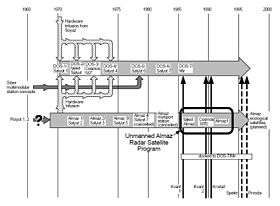
- The large horizontal arrows trace the evolution of the two Soviet space station programs DOS (top) and Almaz-OPS (bottom)
- Dark gray arrows trace the infusions from the Soyuz and OPS programs to DOS
- Solid and dashed black arrows indicate modules intended for Mir, containing influences from OPS with the addition of space tugs
The program was composed of DOS (Durable Orbital Station) civilian stations and OPS (Orbital Piloted Station) military stations:
- The Almaz-OPS space station cores were being designed since October 1964 by Vladimir Chelomei's OKB-52 organization as military space stations, long before the Salyut programme started.[1] For Salyut, small modifications had to be made to the docking port of the OPS to accommodate Soyuz spacecraft in addition to TKS spacecraft.
- The civilian DOS space station cores were being designed by Sergei Korolev's OKB-1 organization – Korolev and Chelomei had been in fierce competition in the Soviet space industry during the time of the Soviet manned lunar programme. In an effort by OKB-1 to catch up with OKB-52, they took Chelomei's Almaz-OPS hull design and mated it with subsystems derived from their own Soyuz.[2] This was done beginning with conceptual work in August 1969.[3] The DOS differed from the OPS modules in several aspects, including extra solar panels, front and (in Salyut 6 and 7) rear docking ports for Soyuz spacecraft and TKS spacecraft, and finally more docking ports in DOS-7 and DOS-8 to attach further space station modules.
When it was realized that the later civilian DOS stations could not only offer a cover story for the military Almaz programme, but could be finished within one year (and at least a year earlier than Almaz), the Salyut programme begun on 15 February 1970 – under the condition that the manned lunar program would not suffer.[2] However, the engineers at OKB-1 immediately switched from the L3 lunar lander effort, which was perceived as a dead-end, to start work on DOS – despite fears that it would kill the Soviet manned Moon shot.[3] In the end it turned out that the Soviet N1 "Moon Shot" rocket never flew successfully, so OKB-1's decisions to abandon the ill-fated Soviet manned lunar program, and to derive a DOS space station from existing Soyuz subsystems and an Almaz/OPS hull proved to be right: The actual time from the DOS station's inception to the launch of the first DOS-based Salyut 1 space station took only 16 months; the world's first space station was launched by the Soviet Union, two years before the American Skylab or the first Almaz/OPS station flew.
Initially the space stations were to be named Zarya, the Russian word for 'Dawn'. However, as the launch of the first station in the programme was prepared, it was realised that this would conflict with the call sign Zarya of the flight control centre (TsUP) in Korolyov – therefore the name of the space stations was changed to Salyut shortly before launch of Salyut 1.[3][4] Another explanation given is that the name might have offended the Chinese, who purportedly were preparing a new rocket for launch, which they had already named "Dawn".[5] The Salyut programme was managed by Kerim Kerimov,[6] chairman of the state commission for Soyuz missions.[7]
While a total of nine space stations were launched in the Salyut programme, with six successfully manned, setting some records along the way, it was the stations Salyut 6 and Salyut 7 that became the workhorses of the program. Out of the total of 1,697 days of occupancy that all Salyut crews achieved, Salyut 6 and 7 accounted for 1,499. While Skylab already featured a second docking port, these two Salyut stations became the first that actually utilized two docking ports: This made it possible for two Soyuz spacecraft to dock at the same time for crew exchange of the station and for Progress spacecraft to resupply the station, allowing for the first time a continuous ("permanent") occupation of space stations.
The heritage of the Salyut programme continued to live on in the first multi-module space station Mir with the Mir Core Module ("DOS-7"), that accumulated 4,592 days of occupancy, and in the International Space Station (ISS) with the Zvezda module ("DOS-8"), that as of 21 August 2012 accumulated 4,310 days of occupancy. Furthermore, the Functional Cargo Block space station modules were derived from the Almaz programme, with the Zarya ISS module being still in operation together with Zvezda.
First generation – The first space stations
Salyut 1 (DOS-1)
Salyut 1 (DOS-1) (Russian: Салют-1; English: Salute 1) was launched on 19 April 1971. It was the first space station to orbit the Earth.
Its first crew launched in Soyuz 10 but were unable to board due to a failure in the docking mechanism; its second crew launched in Soyuz 11 and remained on board for 23 productive days. The world's first successful manned space station mission was however overshadowed when the crew was killed before the re-entry of Soyuz 11 on 30 June 1971 – a pressure equalisation valve in the descent module of the Soyuz had opened prematurely when the three modules of the spacecraft separated, suffocating all three.
Salyut 1 was moved to a higher orbit between July and August 1971 to ensure that it would not be destroyed prematurely through orbital decay. In the meantime, Soyuz capsules were being substantially re-designed to allow pressure suits to be worn during launch, docking maneuvers, and re-entry.[8] However, Salyut 1 ran out of supplies before the Soyuz redesign effort was concluded, and it was decided to fire the engines for the last time on 11 October, to lower its orbit and ensure prompt destructive re-entry over the Pacific Ocean. After 175 days in space, the first real space station came to an end.
DOS-2
DOS-2 was launched on 29 July 1972. It was similar in design to Salyut 1. The second stage of its Proton rocket failed; DOS-2 never reached orbit and crashed into the Pacific Ocean.
Salyut 2 (OPS-1, military)
Salyut 2 (OPS-1) (Russian: Салют-2; English: Salute 2) was launched on 4 April 1973. The space station was, despite its "Salyut 2" designation, slated to be the first military space station, part of the highly classified Almaz military space station program – the Salyut designation was chosen to conceal its true nature. Although it launched successfully, within two days the unmanned Salyut 2 began losing pressure and its flight control system failed; the cause of the failure was likely due to shrapnel from the discarded and exploded Proton rocket upper stage that pierced the station. On 11 April 1973, seven days after launch, an unexplainable accident caused both solar panels to be torn loose from the space station, cutting off all power. Salyut 2 re-entered on 28 May 1973.
Kosmos 557 (DOS-3)
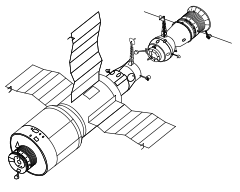
The module DOS-3 was launched on 11 May 1973 – three days before the launch of Skylab – and was slated to become the next civilian space station with a Salyut designation. Due to errors in the flight control system while out of range from ground control, the station fired its orbital-correction engines until it consumed all of its fuel. Since the spacecraft was already in orbit and had been registered by Western radar, the Soviets disguised the launch as "Kosmos 557" – it was revealed to have been a Salyut station only much later. It re-entered Earth's atmosphere a week later, and burned up on re-entry.
Salyut 3 (OPS-2, military)
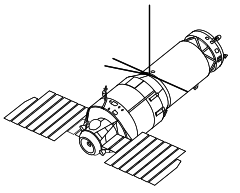
Salyut 3 (OPS-2) (Russian: Салют-3; English: Salute 3) was launched on 25 June 1974. Like Salyut 2, it was another Almaz military space station, although unlike its predecessor, it was launched successfully. It was used to test a wide variety of reconnaissance sensors, returning a canister of film for analysis. On 24 January 1975, after the station had been ordered to deorbit, trials of an on-board autocannon (either a 23 mm Nudelman aircraft cannon or its 30 mm counterpart) were conducted with positive results at ranges from 3000 m to 500 m.[9] Cosmonauts have confirmed that a target satellite was destroyed in the test. The next day, the station was ordered to deorbit. Only one of the two intended crews successfully boarded and crewed the station, brought by Soyuz 14; Soyuz 15 attempted to bring a second crew but failed to dock. Nevertheless, it was an overall success. The station's orbit decayed, and it re-entered the atmosphere on 24 January 1975.
Salyut 4 (DOS-4)
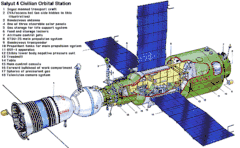
Salyut 4 (DOS-4) (Russian: Салют-4; English: Salute 4) was launched on 26 December 1974. It was essentially a copy of DOS-3, and unlike its ill-fated sibling, it was a complete success. Two crews made stays aboard Salyut 4 (Soyuz 17 and Soyuz 18), including one of 63 days duration, and an unmanned Soyuz capsule (Soyuz 20) remained docked to the station for three months, proving the system's long-term durability. Salyut 4 was deorbited on 2 February 1977, and re-entered the Earth's atmosphere the next day.
Salyut 5 (OPS-3, military)
Salyut 5 (OPS-3) (Russian: Салют-5; English translation Salute 5) was launched on 22 June 1976. It was the third and last Almaz military space station. Its launch and subsequent mission were both completed successfully, with three crews launching and two (Soyuz 21 and Soyuz 24) successfully boarding the craft for lengthy stays (the second crew on Soyuz 23 was unable to dock and had to abort). Salyut 5 reentered on 8 August 1977.
Following Salyut 5, the Soviet military decided that with the advent of more sophisticated spy satellites, the tactical advantages were not worth the expense of the program and withdrew from the programme. The focuses for the last two Salyut stations shifted towards civilian research and prestige for the Soviet Union.
Second generation – Long-duration inhabitation of space
In 1977 another marked step forward was made with the second generation of Salyut stations. The aim was to continuously occupy a space station with long-duration expeditions, for the first time in spaceflight.
Although Salyut 6 and Salyut 7 resembled the previous Salyut stations in overall design, several revolutionary changes were made to the stations and program for the aim of continuous occupation. The new stations featured a longer design life and a second docking port at the aft of the stations – crew exchanges and station "handovers" were now made possible by docking two crewed Soyuz spacecraft at the same time. Furthermore, the uncrewed Progress resupply craft was created based on the crewed Soyuz, to resupply the crew and station with air, air regenerators, water, food, clothing, bedding, mail, propellants, pressurant, and other supplies. While the Progress docked to the station's second docking port, the crew's Soyuz spacecraft could remain docked to the station's first port. The Progress spacecraft even delivered hardware for updating onboard experiments and permitting repairs to the station, extending its life.[10]
Salyut 6 (DOS-5)
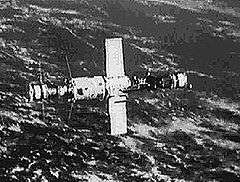
Salyut 6 (DOS-5) (Russian: Салют-6; English: Salute 6) was launched on 29 September 1977. Salyut 6 was visited from 1977 until 1981 by 16 manned spacecraft, bringing five long-duration crews ("expeditions") and 11 short-term crews. The very first long-duration crew on Salyut 6 broke a record set onboard Skylab, staying 96 days in orbit. The short-term crews included foreign cosmonauts from the Interkosmos programme setting several firsts: the first citizen in space of a nation other than the United States or the Soviet Union, the first black and Hispanic person in space and the first Asian person in space. The longest flight onboard Salyut 6 lasted 185 days. The third long-duration Salyut 6 crew deployed a 10-meter radio-telescope antenna delivered by an uncrewed cargo spacecraft.
After Salyut 6 manned operations were discontinued in 1981, a heavy unmanned spacecraft called TKS, developed using hardware left from the canceled Almaz programme, was docked to the station as a hardware test. Some unconfirmed reports say the station was functionally capable of even more missions, but combating the ever-increasing mold in living quarters was becoming impossible, and in practice caused the retirement decision. Salyut 6 was deorbited on 29 July 1982.
Salyut 7 (DOS-6)
Salyut 7 (DOS-6) (Russian: Салют-7; English: Salute 7) was launched on 19 April 1982. DOS-6 was built as the backup vehicle for Salyut 6 with very similar equipment and capabilities, though several more advanced features were included. The station was in orbit for eight years and ten months, during which time it was visited by ten manned spacecraft bringing six long-duration crews ("expeditions") and 4 short-term crews (including French and Indian cosmonauts in the Interkosmos programme).
On 12 February 1985, during an unmanned period, contact with Salyut 7 was lost. The station had become crippled by electrical problems, all systems shut down and the station began to drift. It was decided to put together a salvage mission, and on June 1985 the Soyuz T-13 mission, in what was in the words of author David S. F. Portree "one of the most impressive feats of in-space repairs in history," managed to bring the station online again.[10]
The Soyuz T-15 mission was the last to visit Salyut 7 in 1986, ferrying equipment from Salyut 7 to the new Mir space station; This was so far the only ferry flight between two space stations.
Aside from the many experiments and observations made on Salyut 7, the station also tested the docking and use of large modules with an orbiting space station. These modules, called "Heavy Cosmos modules", helped engineers develop technology necessary to build Mir.
Salyut 7 was deorbited on 7 February 1991.
Salyut's heritage – Modular space stations
After the second generation, plans for the next generation of Salyut stations called for the cores DOS-7 and DOS-8 to allow, for the first time in spaceflight, the addition of several modules to a station core and to create a modular space station. For this, the DOS modules were to be equipped with a total of four docking ports: one docking port at the aft of the station as in the second generation Salyuts, and the replacement of the front docking port with a "docking sphere" containing a front port and starboard docking port.
While the station cores DOS-7 and DOS-8 were built and flown, they never received the Salyut designation. Instead, DOS-7 evolved into the Mir Core Module for the Mir space station that followed the Salyut programme, and DOS-8 was used as the Zvezda Service Module for the International Space Station (ISS) which followed Mir.
The heritage from the Almaz program is present even today. While the last space station from the Almaz programme was flown as Salyut 5 in 1976, the development of the Almaz TKS spacecraft evolved into the Functional Cargo Block, which formed the basis for several Mir modules, the experimental Polyus orbital weapons platform and the Zarya module of the ISS.
Mir Core Module (DOS-7)
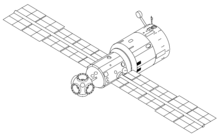
DOS-7 continued to be developed during Salyut 7, becoming the Mir Core Module of the Mir space station – the first modular space station, with crewed operations lasting from 1986 to 2000.
The station featured upgraded computers and solar arrays, and accommodations for two cosmonauts each having their own cabin. A total of six docking ports were available on the Mir Core Module, which were used for space station modules and visiting spacecraft – the docking sphere design had been upgraded from its initial Salyut design to contain a maximum of five docking ports (front, port, starboard, zenith and nadir). And finally, the modules for Mir were derived from the Functional Cargo Block design of the Almaz programme.
The name of the Mir space station – Russian: Мир, literally Peace or World – was to signify the intentions of the Soviet Union to bring peace to the world. However, it was during the time of Mir that the Soviet Union was dissolved in 1991, ending what was begun with the 1917 October Revolution in Russia. This dissolution had started with the Soviet "perestroika and glasnost" ("restructuring and openness") reform campaigns by Soviet leader Mikhail Gorbachev in the 1980s, had reached a preliminary endpoint with the revolutions of 1989 and the end of the communist Eastern Bloc (Warsaw Pact and the CoMEcon), finally to reach the Soviet Union itself in 1991.
While the Russian Federation became the successor to much of the dissolved Soviet Union and was in a position to continue the Soviet space program with the Russian Federal Space Agency, it faced severe difficulties: imports and exports had steeply declined as the economic exchange with CoMEcon nations had crumbled away, leaving the industry of the former Soviet Union in shambles. Not only did the political change in eastern Europe signify an end of contributions to the space program by eastern European nations (such as the East German Carl Zeiss Jena), but parts of the Soviet space industry were located in the newly independent Ukraine, which was similarly cash-strapped as Russia and started to demand hard currency for its contributions.
It was during this time of transition and upheaval that the Shuttle–Mir Program was established between the Russian Federation and the United States in 1993. The former adversaries would now cooperate, with "Phase One" consisting of joint missions and flights of the US Space Shuttle to the Mir space station. It was a partnership with stark contrasts – Russia needed an inflow of hard currency to keep their space program aloft, while in the US it was seen as a chance to learn from the over 20 years of experience of Soviet space station operations. It was "Phase Two" of this Shuttle-Mir Program that would lead to the International Space Station.
Zvezda ISS Service Module (DOS-8)
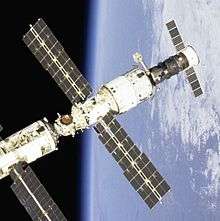
DOS-8 evolved into the Mir-2 project, intended to replace Mir. Finally, it became the International Space Station (ISS) Zvezda Service Module and formed the core of the early ISS together with the Zarya module (which was derived from Almaz Functional Cargo Block designs).
Data table
| Space Station |
Core module |
Launched | Reentered | Days in orbit |
Days occupied |
All crew and visitors (total) |
Visiting manned spacecraft |
Visiting unmanned spacecraft |
Mass kg |
|---|---|---|---|---|---|---|---|---|---|
| Salyut 1 | DOS-1 | 19 April 1971 01:40:00 UTC |
11 October 1971 |
175 | 23 | 3 | 2 | - | 18,500 |
| - | DOS-2 | 29 July 1972 | 29 July 1972 | - | - | - | - | - | 18,000 |
| Salyut 2 | OPS-1 (military) | 4 April 1973 09:00:00 UTC |
28 May 1973 |
54 | - | - | - | - | 18,500 |
| - (Kosmos 557) |
DOS-3 | 11 May 1973 00:20:00 UTC |
22 May 1973 |
11 | - | - | - | - | 19,400 |
| Salyut 3 | OPS-2 (military) | 25 June 1974 22:38:00 UTC |
24 January 1975 |
213 | 15 | 2 | 1 | - | 18,500 |
| Salyut 4 | DOS-4 | 26 December 1974 04:15:00 UTC |
3 February 1977 |
770 | 92 | 4 | 2 | 1 | 18,500 |
| Salyut 5 | OPS-3 (military) | 22 June 1976 18:04:00 UTC |
8 August 1977 |
412 | 67 | 4 | 2 | - | 19,000 |
| Salyut 6 | DOS-5 | 29 September 1977 06:50:00 UTC |
29 July 1982 |
1764 | 683 | 33 | 16 | 15 | 19,824 |
| Salyut 7 | DOS-5-2 | 19 April 1982 19:45:00 UTC |
7 February 1991 |
3216 | 816 | 26 | 10 | 15 | 18,900 |
| For comparison, the DOS-7 and DOS-8 modules that were derived from the Salyut programme: | |||||||||
| Mir | DOS-7 Mir Core Module |
19 February 1986 |
23 March 2001 |
5511 | 4,592 | 104 | 39 | 64 | 20,400 |
| ISS | DOS-8 Zvezda ISS Service Module |
12 July 2000 |
Still in orbit | 7277 | 6,392 | 205 | 77 (ROS and USOS) |
59 (ROS and USOS) |
19,051 |
All data for Zvezda (DOS-8) as of 6 May 2018.
See also
References
- ↑ "Russianspaceweb.com – The Almaz program".
- 1 2 Sven Grahn. "Salyut 1, its origin".
- 1 2 3 "Encyclopedia Astronautica – Salyut".
- ↑ Payson, Dmitri (June 1, 1993). We’ll Build a Space Station for a Piece of Bread (Translated in JPRS Report, Science & Technology, Central Eurasia: Space, June 28, 1993 (JPRSUSP-93-003) ed.). Rossiskiye Vesti. p. 67.
- ↑ Chertok, Boris E. (2011). Siddiqi, Asif A., ed. Rockets and People (PDF). NASA History Series. 4. National Aeronautics and Space Administration. p. 306. ISBN 978-0-16-089559-3. SP-2011-4110.
- ↑ Chladek, Jay (2017). Outposts on the Frontier: A Fifty-Year History of Space Stations. University of Nebraska Press. pp. 85–86. ISBN 978-0-8032-2292-2.
- ↑ Ivanovich, Grujica S. (2008). Salyut - The First Space Station: Triumph and Tragedy. Springer Science+Business Media. p. 56. ISBN 978-0-387-73585-6.
- ↑ Baker, Philip (2007). The Story of Manned Space Stations: an introduction. Berlin: Springer. p. 25. ISBN 0-387-30775-3.
- ↑ James Olberg, Space Power Theory, Ch. 2
- 1 2 Portree, David (March 1995). "Mir Hardware Heritage" (PDF). NASA. Archived from the original (PDF) on 3 August 2009. Retrieved 24 August 2012.
External links
| Wikimedia Commons has media related to Salyut. |
- Bluth, B. J.; Helppie, Martha (August 1986). Soviet Space Stations as Analogs (PDF) (2nd ed.). California State University. NASA CR-180920; N87-21996.
- Portree, David S. F. (March 1995). Mir Hardware Heritage (PDF). NASA. NASA RP-1357. Archived from the original (PDF) on 2003-04-19.
- "Diaries of the Salyut missions" at Zarya.info
- "Skylab-Salyut Space Laboratory (1972)" at Wired.com
.jpg)